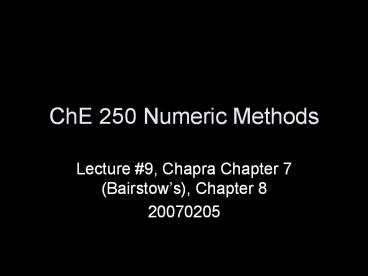ChE 250 Numeric Methods - PowerPoint PPT Presentation
Title:
ChE 250 Numeric Methods
Description:
Whereas the Mullers Method is analogous to the ... For Bairstow, we rely on deflation of the polynomial. Guess a quadratic devisor ... Polynomial Deflation ... – PowerPoint PPT presentation
Number of Views:361
Avg rating:3.0/5.0
Title: ChE 250 Numeric Methods
1
ChE 250 Numeric Methods
- Lecture 9, Chapra Chapter 7 (Bairstows),
Chapter 8 - 20070205
2
Roots of Polynomials
- Friday
- Mullers Method
- Today
- Bairstows Method
- Root location with Excel
- Matlab, Scilab
Case Studies
- Chemical Engineering Problems
3
Bairstows Method
- Whereas the Mullers Method is analogous to the
secant method and is fairly straightforward to
understand, the Bairstow method is fundamentally
different - For Bairstow, we rely on deflation of the
polynomial - Guess a quadratic devisor
- Iterate the coefficients of the quadratic
- repeat the division until the quotient is second
or first order - The only trick is how we find the devisor
4
Bairstows Method
- Polynomial Deflation
- Removing the found roots from a polynomial so you
can find the remaining roots - For this equation, once we find x-1, 4 then we
want to remove those two and concentrate on the
others - The process is then repeated which removes two
more roots and only one is left
5
Bairstows Method
- Starting with a general polynomial with
coefficients an - An initial guess of s, r for the coefficients of
a quadratic, gives a set of bn that form a new
deflated polynomial with order n-2
6
Bairstows Method
- Synthetic division is easily implemented in a
program using this algorithm - The final b values (0,1) are the remainder term
which we want to be 0 - Since b0 and b1 are functions of r and s, they
can be written in a Taylor expansion (first
order!) - Set both b0 and b1 equal to zero and solve for
delta s and r
7
Bairstows Method
- But what about the partials?
- A new coefficient, c, can be used to determine
the partials - Use the same sub used for b to determine c
- Only c 1,2,3 are used
Same algorithm
8
Bairstows Method
- Substitute the cs for the partials
- And then solve two equations and two unknowns,
delta r and delta s - We then use these deltas to calculate the next
values, ri1 and si1 - Example 7.3
- Questions?
9
Excel Goal Seek
- Useful for functions of one variable
- Heavily dependant on initialization
- Will abort if it finds a complex situation or
other errors - Great for a first try at a solution!
10
Excel Solver
- Powerful tool for finding solutions to
multivariate problems - Constraints keep the solution from returning
nonsensical solutions or find a distinct solution - First choice for multivariate problems with real
solutions
11
Matlab
- If you have not used Matlab before or it has been
a while, please brush up by trying example 7.7 - Understand how to perform calculations and assign
variable names - Create a function of several variables
- Lab will be tomorrow night with times per e-mail
12
Preparation for Feb 7th
- Reading
- Chapra Part 3 intro, Chapter 9 Gauss
Elimination - Reminder Homework due Feb 7th
- Chapter 6
- 6.2, 6.7, 6.9, 6.11, 6.12, 6.13
- Chapter 7
- 7.4, 7.5, 7.12, 7.18, 7.19a
- Chapter 8
- 8.1, 8.2































